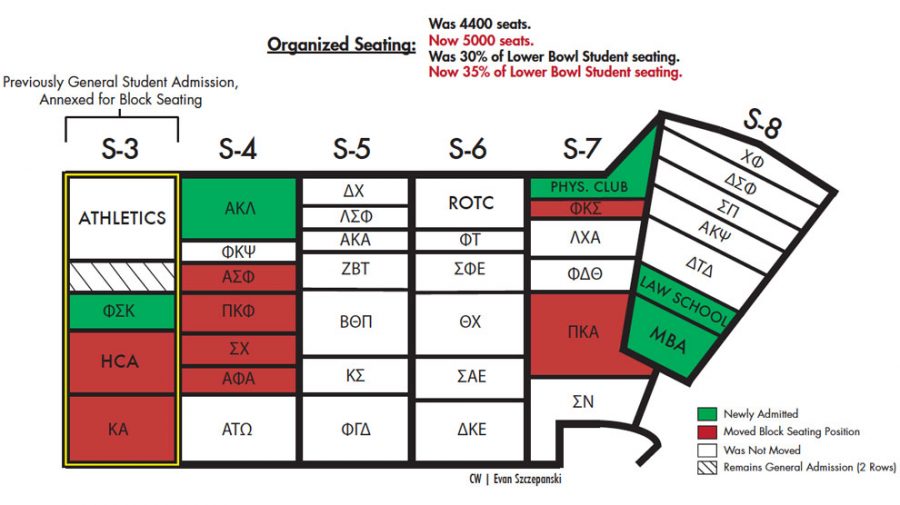The University has decided to expand Student Organization Seating into section S-3 of the lower bowl of Bryant-Denny Stadium, reserving 33 of 35 rows previously open to all student ticketholders.
At a meeting of the Student Organization Seating Committe on Tuesday night, members voted on a revised seating chart that will take effect for the North Texas game this Saturday. The chart reduces general admission seating by an estimated total of 580 seats and, as a result, places almost all student seating behind the south end zone in the block seating program.
“Because of the significant amount of miscommunication about the procedures, and after being asked to review the initial decision by the SOS committee and several student groups who were impacted by the committee’s decision, I agreed to a one-time, non-precedent-setting addition of seats,” said Mark Nelson, University of Alabama vice president for Student Affairs. The decision brings the number of seats reserved for Student Organization Seating to an estimated 5,000 seats, over a third of lower bowl student seating.
Megan St. John, a senior majoring in nursing who sat in section S-3 for every game she attended last season, had planned to do so again this year and said she is saddened to learn the area will now be used for block seating.
“That truly does break my heart,” she said. “I’m not surprised that they took it into block seating, I figured it was only a matter of time before they took it away. I am disappointed, because I think that section allows non-greek students to sit in a more optimal viewing area. But at the same time, I think I’d probably still sit there. If they want to kick me out, they can.”
Before the first home game against Kent State two weeks ago, administration officials had planned to issue citations for Student Non-academic Misconduct (SNAM) to students who sat in an organization’s reserved block. Because block seating is not mentioned in the Code of Student Conduct, and the University has no policy authorizing its existence, the SNAMs were to be given for not following the instructions of faculty members.
However, when asked if SNAMs would be issued to students who continue to sit in section S-3, Nelson said, “Once again, we will call on our students to be courteous, to demonstrate good sportsmanship and to fully cooperate with University officials.”
As a result of the expansion, the Student Bar Association, MBA Program, Exercise and Physiology Club, Alpha Kappa Lambda and Phi Sigma Kappa will all receive block seating privileges. The five groups had applied for seating last month, but their applications were discarded without being reviewed by the seating committee.
“The groups had incomplete applications,” said SGA communications director Seth Morrow. “But per a directive from the Division of Student Affairs, the committee met again to allocate seats to the five groups.”
Will Pylant, an SGA senator who serves on the seating committee, said he was satisfied with the new plan.
“On Tuesday, we passed a map that is fair to all parties concerned,” he said. “I was pleased with the friendly tone of debate and the general agreement between committee members.”
Morrow agreed.
“We are excited that more organizations are receiving seating this year than last year,” Morrow said, “and we look forward to continuing to mold the process to better serve all students.”
SGA press secretary Katie O’Laughlin said a task force is being formed to make recommendations for improving block seating.
“In the coming weeks, a task force will be created to draft a proposal for the future of Student Organization Seating,” she said.
O’Laughlin said the review team will include members from each branch of SGA and a chairman appointed by the Dean of Students’ Office. It will solicit student opinion, research the process at other institutions and present a proposal to SGA President Grant Cochran and Nelson.
“I have asked for clear objectives and procedures to be developed, and I understand that SGA President Grant Cochran has also asked for the same thing,” Nelson said. “While I believe it is important for the SGA to lead the effort to clarify our objectives and procedures related to the current SOS structure, I also believe it is important to understand the various options available to us in light of the growing demand for SOS. As such, I have asked the [Campus and Student Life Standing Committee] to research best practices from across the country and to submit a report by the end of this semester.”
Hailey Grace Allen and Elisabeth Garcia contributed to this report.









